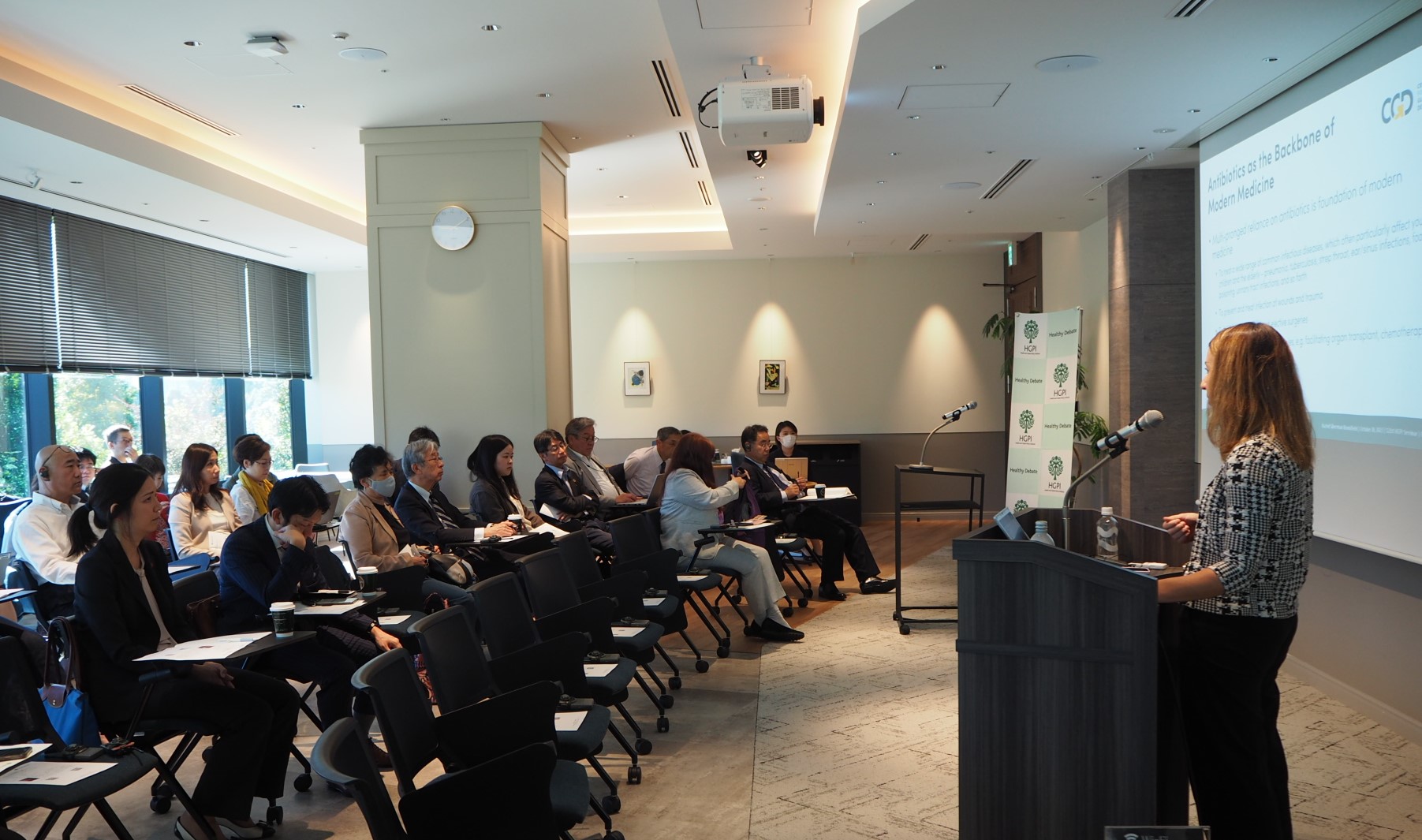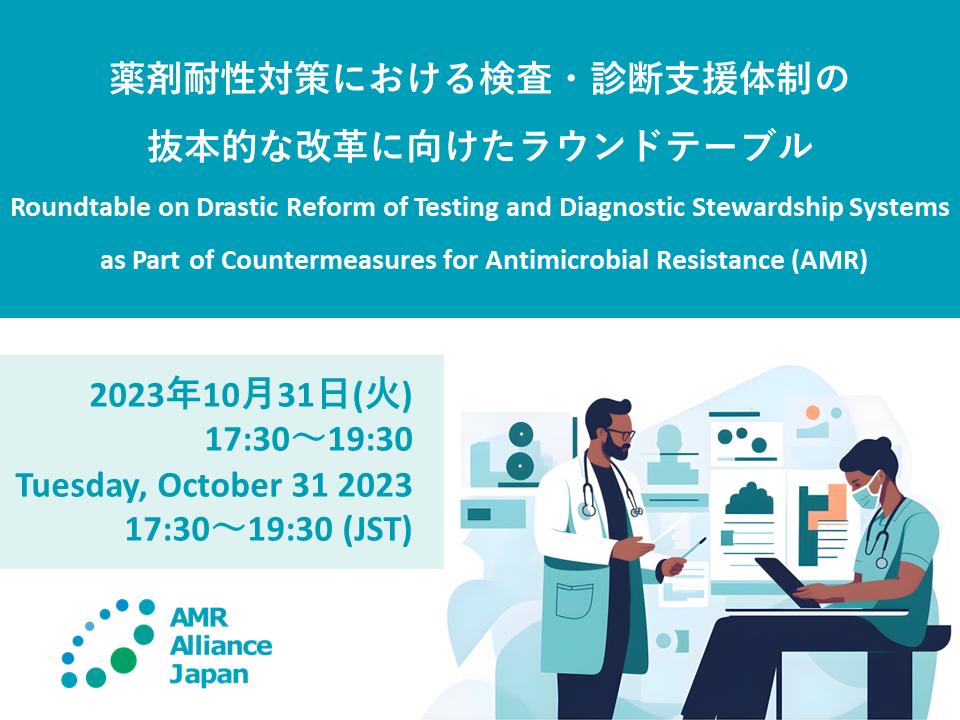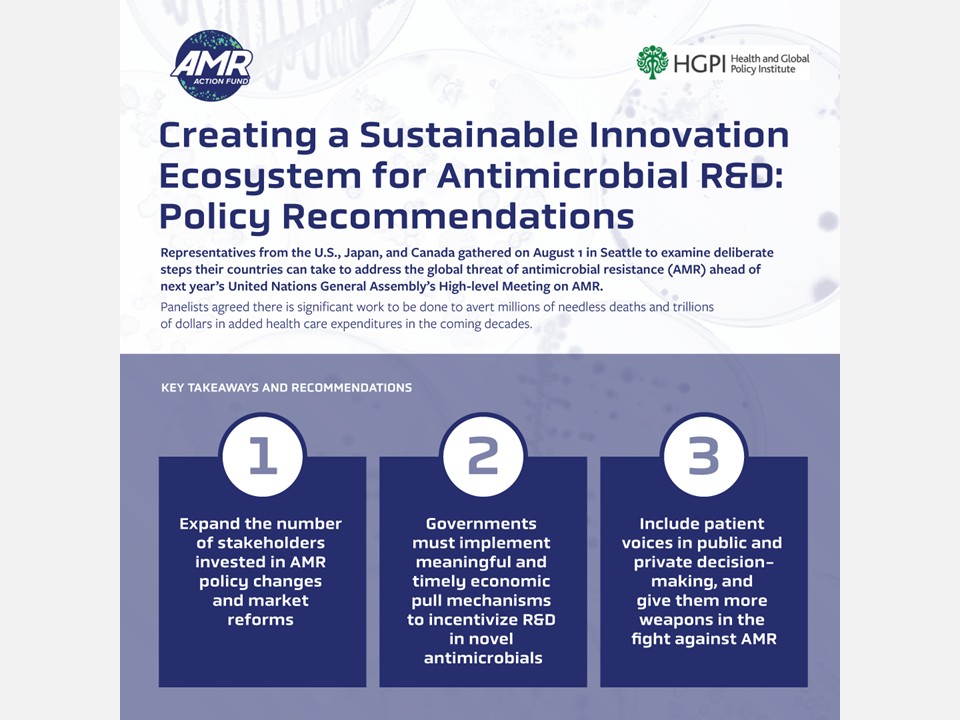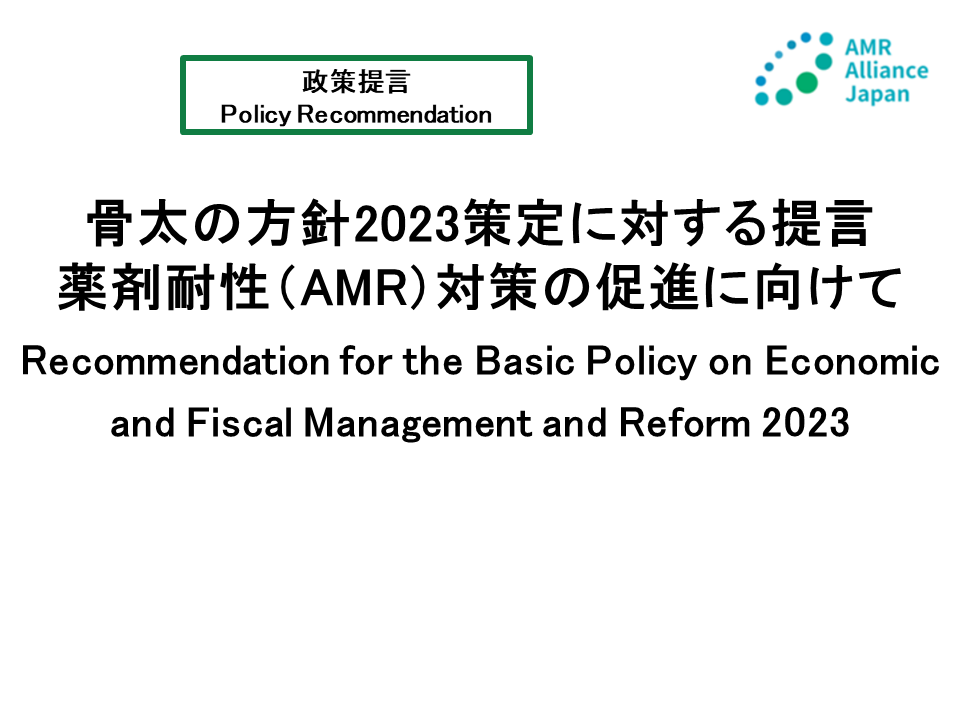[Event Report] The 121st HGPI Seminar – Addressing AMR as a Global Health Challenge: Integrating Perspectives from LMICs and HICs for Sustainable Access to Antibiotics (October 30, 2023)
date : 12/1/2023
Tags: AMR, HGPI Seminar
![[Event Report] The 121st HGPI Seminar – Addressing AMR as a Global Health Challenge: Integrating Perspectives from LMICs and HICs for Sustainable Access to Antibiotics (October 30, 2023)](https://hgpi.org/en/wp-content/uploads/sites/2/hs121-top_JPNENG-1-2.png)
For the 121st HGPI Seminar, we hosted Ms. Rachel Silverman Bonnifield, a senior fellow at the US think tank, Center for Global Development. In this seminar Ms. Bonnifield discussed antimicrobial resistance (AMR) as a global health crisis. She highlighted the need for collaboration and agreement across geographical, economic, industrial, and sectoral borders to address the ongoing burden of antibiotic-treatable disease and ensure that all people, including those in low- and middle-income countries (LMICs), can access lifesaving antibiotics when needed both now and in the future.
Key Points of the Lecture
- Antibiotics play a critical role in modern medicine, however, the rise of AMR poses a significant threat to global health in high income countries (HICs) and LMICs alike.
- LMICs bear the brunt of the burden, accounting for nearly 90 percent of AMR-related deaths.
- A “Grand Bargain” is needed to balance the interests of HICs, who prioritize antibiotic stewardship and innovation, with LMICs urgent need for increased access to address the ongoing burden of antibiotic-treatable disease.
- With Japan’s relatively high burden of drug resistant infections, a “Grand Bargain” will be a good deal and bring a high return on investment.
AMR is a global health and development issue
Antibiotics are useful across the entire burden of disease and are essential for everything we manage from noncommunicable diseases to injury, not just for treating infection. We rely on antibiotics for basically every part of modern medicine. In HICs like Japan, antibiotic treatment is considered as a clinical management issue. However, with the rise of AMR there are important discussions around antibiotic use and prescribing, procurement systems, and new antibiotic R&D that need to be held among governments, civil society, and as a part of the national policy conversation.
In Japan alone, there are about 20,000 people dying every year from drug resistant infections. Looking at the global picture, the numbers are much larger, with about 1.3 million deaths per year attributable to antibiotic resistance. We think about this as something that’s going to be very bad in the future, but it’s already here today, and already people are dying from this. Overwhelmingly, these deaths are occurring in LMICs where they are bearing most of the burden. And unlike in HICs where those deaths tend to be in older populations, in LMICs deaths caused by antibiotic resistance are among young children.
When thinking about AMR as a global health challenge, consider these three questions:
- How do we collectively conserve antibiotic efficacy, across countries with extremely different contexts, disease burdens, resource constraints, and capabilities?
- How do we ensure wider, better access to antibiotics to alleviate the unacceptable burden of infectious disease – while continuing to sustain their efficacy?
- How do we work collaboratively to build a robust pipeline of new antibiotics – and, then, ensure those are widely available to all that need them and responsibly used?
Differing AMR perspectives and priorities across LMICs and HICs
In AMR policy, we often think about the three legs of a stool, access, innovation, and stewardship as the three factors needed for a sustainable antimicrobial market. All three are necessary to hold the stool up, so without any one of these, it doesn’t work. For example, if you have access, without stewardship, it speeds resistance and undermines innovation. If you have stewardship, but you don’t have widespread access, it constrains access, and it can undermine innovation, because it means companies cannot sell as much of their drugs, and therefore they make less money. Without other measures to promote innovation, it can hurt innovation and access. And then innovation itself is unjust without access if it does not get to all who need it, and it’s also wasteful without stewardship and not used responsibly.
While HICs and LMICs can agree that all these issues are important, they prioritize them differently. The basic theme that emerged out of interviews with policymakers is that in HICs, people talk about and prioritize innovation and stewardship in the discussion. In LMICs, they prioritize access and a bit of stewardship, and less of innovation, since they don’t often get the drugs they need anyway. One of the policymakers interviewed summed up the differences saying the following.
“There’s a divergence of interests between the Global North and South. The Global North is interested in new antibiotic production, R&D, stewardship, and surveillance. This is being done to identify threats to the Global North—not to help the Global South. The Global South is more interested in infection burden and reducing infectious disease.”
So, there is a perception among LMICs, that while they are affected by antimicrobial resistance, the policy conversation that is being pushed by HICs, is not looking out for their interests necessarily.
The “Grand Bargain” to ensure sustainable access to antibiotics for all
We can foresee that in the future, the coming AMR crisis will also be a diplomatic crisis. Remember COVID-19 and the fights over vaccines and access to medicines, that will happen for antibiotics too, and it will be very diplomatically challenging and create a lot of problems between countries. At the same time, antibiotic efficacy is a scarce resource. There’s an urgency of dealing with this now because there is a lag time in the R&D pipeline. If we want drugs to be available in 10, 20, 30 years, we need to signal now to industry, what the market will look like for antibiotics and what access obligations will be like.
A “Grand Bargain” is needed to balance the interests of HICs, who prioritize antibiotic stewardship and innovation, with LMICs urgent need for increased access to address the ongoing burden of antibiotic-treatable disease. The “Grand Bargain” needs to accomplish the following:
- Give HICs confidence/incentive to invest in new antibiotics and share those broadly with the world
- Ensure LMICs have access to needed antibiotics, while securing their buy-in for stringent stewardship of last-resort drugs
- Keep industry engaged/incentivized to develop new antibiotics that serve all global needs
The “Grand Bargain” is envisioned as a deal between four parties, HIC governments, the governments of LMICs, the pharmaceutical industry, and international organizations.
- HIC governments would take on the main role of adequately funding R&D and support clinical trials.
- LMIC governments would also support in the clinical trials, but also work to reduce unnecessary barriers to access and stewardship.
- The pharmaceutical industry would be responsible for R&D in critical areas that meet all countries needs and ensure access and availability.
- The international organization role would be to coordinate between countries and ensure that commitments are followed.
The idea is that all the stakeholders would have certain rights and expectations, but they would also have responsibilities that they need to fulfill. This is a mutual obligation among all parties to be part of this constructive solution.
Japan’s perspective of the “Grand Bargain” as a good deal for HICs
Under the “Grand Bargain”, it is up to HICs to pay for the cost of innovation. This is their main monetary obligation with a high price tag, estimated at around 4.5 billion USD needed in pull incentives for each new antibiotic. If we imagine that we need 18 new antibiotics over the next 30 years, the total nominal cost is 81 billion USD. Considering the G7 countries and dividing that price tag by the different members’ relative GDP, for Japan, it would be about 10% of the overall total, which is a financial obligation of about 443 million USD per new drug.
So how do we calculate value for money and think about the return on investment from Japan’s perspective?
By looking at just the direct benefits of patients from drug resistant infections; the direct health gain to patients from the treatment of drug resistant infections and averted hospital costs that are directly associated with drug resistant infections. Based on the policy parameters that were applied in the health technology assessment (HTA) by the Japanese government, we looked at the return on investment over 10 years and 30 years. We found that every dollar or yen invested would pay off 6 USD or JPY in 10 years. So, in 10 years, the return on investment is 6 to 1. And over 30 years, the return on investment is 28 to 1. We did this also for all the other G7 members, and for every country, it’s very good value for money in a very good return on investment. Although for Japan, it’s higher than the EU, Canada, and the UK because Japan has now a relatively high burden of drug resistant infections compared to these other countries.
The key takeaway about the “Grand Bargain” for Japan is:
- Financial contribution to innovation is great value from a domestic perspective, alone.
- Legitimacy and leveraged influence in protecting last-resort antibiotics (reserve) from misuse (e.g., globally governed stewardship system).
- Diplomatic and altruistic benefits in helping save millions of lives around the world, with up-front deal pre-empting later contentious debate about access to medicines, patents, etc.
The burden of AMR is disproportionately borne by the poorest countries—which also suffer from a lack of access to antibiotics, so, the AMR crisis demands a response at the clinical, national policy, and international diplomacy levels. The “Grand Bargain” can structure countries respective roles and responsibilities in the response, to meet the needs of all parties and is a good deal for HICs, including Japan.
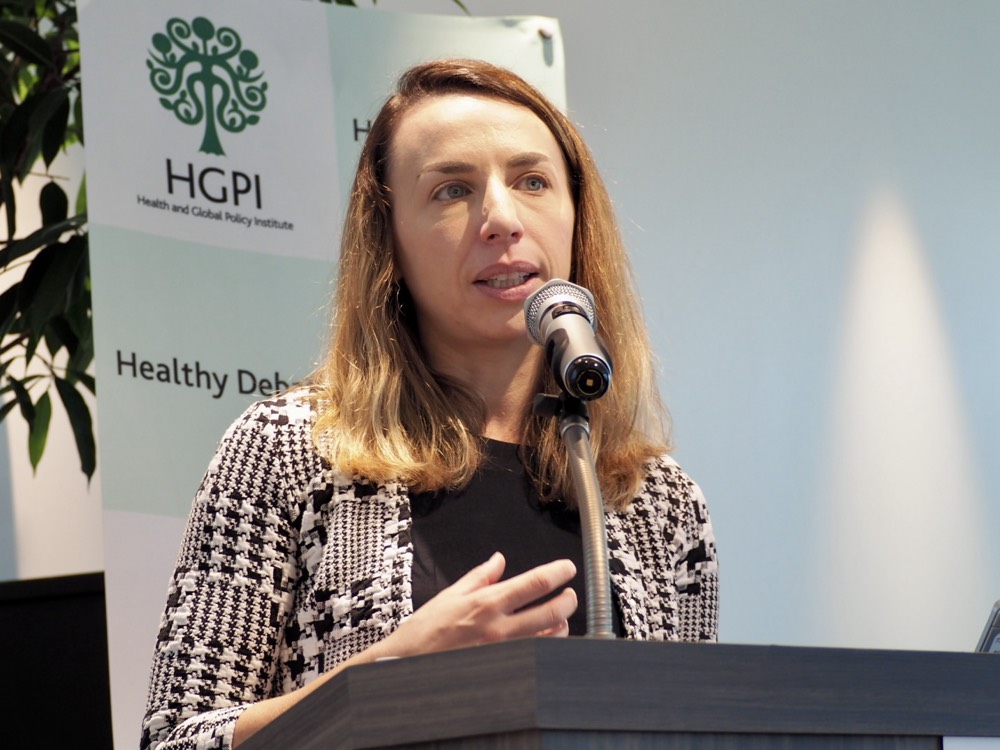 |
|
[Event Overview]
- Speaker: Ms. Rachel Silverman Bonnifield (Senior Fellow, The Center for Global Development (CGD))
- Date & Time: Monday, October 30, 2023; from 9:00 to 10:00 JST (Doors Open 8:30)
- Format: In-person (No online streaming)
- Venue: STUDIO&LOUNGE 3F Yotsuya Tower, Comore Yotsuya, 1-6-1, Yotsuya, Shinjuku-ku, Tokyo
- Language: English and Japanese (simultaneous translation will be available)
- Hosted by: Health and Global Policy Institute / AMR Alliance Japan
- Sponsored by: National Graduate Institute for Policy Studies (GRIPS) GlobalHealth Innovation Policy Program
- Participation fee: Free
- Capacity: 40
■ Speaker Profile:
Ms. Rachel Silverman Bonnifield (Senior Fellow, The Center for Global Development (CGD))
Rachel Silverman Bonnifield is a Senior Fellow at the Center for Global Development. Her current research focuses on procurement and access models for global health products; incentives for global health innovation and delivery; neglected global health crises such as the spread of antimicrobial resistance and widespread lead poisoning of children; and financing for pandemic preparedness and response. In addition to her role with CGD, she has also consulted extensively with the World Bank, including authorship of the most recent Flagship Report on the future of primary health care. Previously, she worked with the National Democratic Institute to support democracy and governance strengthening programs in Kosovo. She holds a Master of Philosophy with distinction in public health from the University of Cambridge and a BA with distinction from Stanford University.
Top Research & Recommendations Posts
- [Research Report] Perceptions, Knowledge, Actions and Perspectives of Healthcare Organizations in Japan in Relation to Climate Change and Health: A Cross-Sectional Study (November 13, 2025)
- [Policy Recommendations] Mental Health Project: Recommendations on Three Issues in the Area of Mental Health (July 4, 2025)
- [Research Report] The 2025 Public Opinion Survey on Healthcare in Japan (March 17, 2025)
- [Research Report] The 2023 Public Opinion Survey on Satisfaction in Healthcare in Japan and Healthcare Applications of Generative AI (January 11, 2024)
- [Policy Recommendations] Developing a National Health and Climate Strategy for Japan (June 26, 2024)
- [Policy Recommendations] Recommendations on Strategic Investments in Policies for Brain Health to Revitalize Japan: Hopes for the New Administration (December 1, 2025)
- [Policy Recommendations] Reshaping Japan’s Immunization Policy for Life Course Coverage and Vaccine Equity: Challenges and Prospects for an Era of Prevention and Health Promotion (April 25, 2025)
- [Announcement] HGPI Endorses the “Belém Health Action Plan” (November 14, 2025)
- [Announcement] HGPI Joins Global Green and Healthy Hospitals (August 1, 2023)
- [Research Report] AMR Policy Update #2: WHO’s First Report on Fungal Infection—Bridging the Gap Between Clinical Practice and R&D
Featured Posts
-
2025-12-09
[Event Report] Special Seminar “Rising to New Challenges in Health Sciences for Future Society: Novel Developments in the Field of Epilepsy in Japan and Globally” Belgium Pavilion Special Seminar, World Expo 2025 Osaka, Kansai (September 18, 2025)
![[Event Report] Special Seminar “Rising to New Challenges in Health Sciences for Future Society: Novel Developments in the Field of Epilepsy in Japan and Globally” Belgium Pavilion Special Seminar, World Expo 2025 Osaka, Kansai (September 18, 2025)](https://hgpi.org/en/wp-content/uploads/sites/2/HGPI_20250805_mental-health-expo-eyechatch.png)
-
2025-12-11
[Event Report] Core Components of Universal Health Coverage (UHC): Achieving “Healthcare Without Financial Hardship” in Asia-Pacific and Japan (December 5, 2025)
![[Event Report] Core Components of Universal Health Coverage (UHC): Achieving “Healthcare Without Financial Hardship” in Asia-Pacific and Japan (December 5, 2025)](https://hgpi.org/en/wp-content/uploads/sites/2/HGPI_20251210_Core-Components-of-Universal-Health-CoverageUHC-top.jpg)
-
2025-12-12
[Registration Open] Meaningful Involvement Promotion Project Urgent Symposium “The New Takaichi Administration and Central Social Insurance Medical Council Reform – Ensuring Patients’ Voices are Heard” (January 22, 2026)
![[Registration Open] Meaningful Involvement Promotion Project Urgent Symposium “The New Takaichi Administration and Central Social Insurance Medical Council Reform – Ensuring Patients’ Voices are Heard” (January 22, 2026)](https://hgpi.org/en/wp-content/uploads/sites/2/HGPI_20251208_urgent-symposium-1.png)
-
2025-12-12
[Registration Open] (Webinar) The 140th HGPI Seminar “Early Detection to Reduce COPD Disease Burden: Connecting Clinical Frontiers with Health Policy” (January 27, 2026)
![[Registration Open] (Webinar) The 140th HGPI Seminar “Early Detection to Reduce COPD Disease Burden: Connecting Clinical Frontiers with Health Policy” (January 27, 2026)](https://hgpi.org/en/wp-content/uploads/sites/2/hs140-top.png)
-
2025-12-16
[Discussion Points] Policy Dialogue “Considering Comprehensive Genomic Profiling from the Perspective of Patient Access: Utilizing the Medical Service Fee Reimbursement System and the Mixed Medical Services Program to Meet the Needs of Today” (November 28, 2025)
![[Discussion Points] Policy Dialogue “Considering Comprehensive Genomic Profiling from the Perspective of Patient Access: Utilizing the Medical Service Fee Reimbursement System and the Mixed Medical Services Program to Meet the Needs of Today” (November 28, 2025)](https://hgpi.org/en/wp-content/uploads/sites/2/eyecatch_Policy-Dialogue_Discussion-Points_20251128.jpg)




